|
Author
|
Topic: Apollo command module Block I hatch design
|
RichieB16
Member Posts: 594
From: Oregon
Registered: Feb 2003
|
 posted 04-30-2009 11:22 AM
posted 04-30-2009 11:22 AM
   
I have done a little research into the early Block I Apollo capsules and there are a few things that still aren't clear to me concerning the hatch design. As we all know, Apollo 1 had an inward opening hatch which is considered by many to be one of the fatal flaws that doomed the crew.I assume the inward opening hatch was the inner hatch only and the outer hatch was still outward opening (the hatch on the boost protective cover). Is that correct? With the (inner) hatch being inward opening, which way did it open? It seems like it would be difficult for the spacecraft to have an inward opening hatch and allow the crew to enter the spacecraft and get to their couches without a lot of trouble. Does anyone have a picture showing the Apollo 1 capsule with the hatch open so you can clearly see it? |
Delta7
Member Posts: 1576
From: Bluffton IN USA
Registered: Oct 2007
|
 posted 04-30-2009 12:01 PM
posted 04-30-2009 12:01 PM
   
I believe the inner hatch was completely removed after being unbolted, rather than opening and closing on a hinge mechanism. It would then be set on the floor behind the couches and not obstruct egress/ingress. I could be wrong. |
Apolloman
Member Posts: 152
From: Ledignan, Gard (30), France
Registered: Mar 2009
|
 posted 04-30-2009 03:34 PM
posted 04-30-2009 03:34 PM
   
Diagram: Block 1 Hatch, but it's French...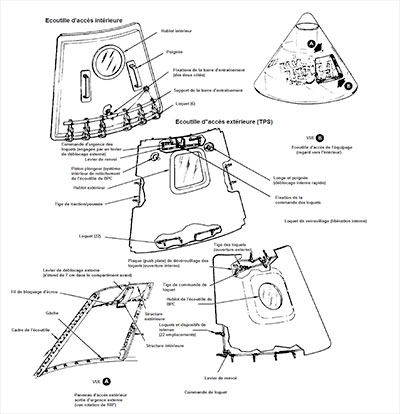 |
mikej
Member Posts: 483
From: Germantown, WI USA
Registered: Jan 2004
|
 posted 04-30-2009 06:38 PM
posted 04-30-2009 06:38 PM
   
A description of the Block I hatch from "The Apollo Command Module Side Access Hatch System" goes nicely with the above diagram: Spacecraft 012 had three hatches located in and latched to the three command module structures: - The inner structure hatch was an inward-opening, completely removable, lightweight structure designed to react the applied loads with interlocking edge members on three sides and latches on the fourth. Cabin pressure was used to aid in sealing; the pressure differential had to be balanced before the hatch could be removed and stowed.
- The heat shield hatch was an outward-opening, removable structure with interlocking edge members and latches on four sides.
- The boost protective cover hatch was a removable lightweight structure of fiber glass and cork, which opened outward. Its latches could be opened from within the command module by manually striking a plunger which penetrated the heat shield hatch and contacted the boost protective cover latch mechanism. It could also be opened from the outside by the use of a special tool.
The basic procedure for egress was to: - Equalize pressure across the inner structure hatch.
- Unlatch and remove the inner structure hatch and stow inside the command module.
- Strike the plunger to open the boost protective cover hatch latches.
- Unlatch the heat shield latches.
- Push the heat shield hatch and boost protective hatch outboard.
- Egress.
This hatch system was deemed acceptable for early Apollo spacecraft (designated Block I) because there was no firm requirement for extravehicular activity, and a 90-s egress time for the three astronauts was thought to be sufficient. Previous consideration for using a large explosive blowout panel for simultaneous exit for three astronauts was eliminated because of the danger of pyrotechnics inside the crew compartment. |
mikej
Member Posts: 483
From: Germantown, WI USA
Registered: Jan 2004
|
 posted 04-30-2009 07:03 PM
posted 04-30-2009 07:03 PM
   
I dug up some low-res scans of some Block I hatch pictures I happened upon somewhere or another on the net. I don't have any higher-res versions of these pictures, nor have I been able to Google them up.   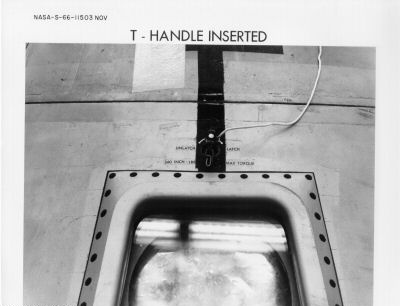 |
RichieB16
Member Posts: 594
From: Oregon
Registered: Feb 2003
|
 posted 04-30-2009 10:42 PM
posted 04-30-2009 10:42 PM
   
Okay, so the inner hatch was inward opening, but wasn't really hinged to hold in. It was to be completely removed and placed behind the couches. Am I understanding this correct? |
Apolloman
Member Posts: 152
From: Ledignan, Gard (30), France
Registered: Mar 2009
|
 posted 05-01-2009 01:56 AM
posted 05-01-2009 01:56 AM
   
Yes it is correct. |
Explorer1
Member Posts: 236
From: Los Angeles, CA, USA
Registered: Apr 2019
|
 posted 04-26-2018 03:52 AM
posted 04-26-2018 03:52 AM
  
One of the problems with the Block I command module was its hatch door. It was very heavy and cumbersome to open. Does anyone know the definitive reason (without guessing) why the Block I hatch was made to be so cumbersome?Editor's note: Threads merged. |
oly
Member Posts: 1093
From: Perth, Western Australia
Registered: Apr 2015
|
 posted 04-26-2018 05:33 AM
posted 04-26-2018 05:33 AM
   
The original hatches were designed to plug a hole in the side of the command module. They were not designed to be opened in orbit. The inner hatch needed to cover an area designed for a fully suited astronaut to climb through so it needed to be large. The most efficient way for it to seal was for it to be installed from inside, acting as a plug, where the air pressure inside the capsule forced the plug into the hatchway. By design this hatch did not sit streamlined to the outer surface of the command module, for this was a heat shield "cover" that was designed to withstand re-entry temperatures. The third hatch was basically a hatch through the boost protective cover, designed to survive launch velocity. The unified hatch (Block II) combined the first and second hatch together, opening outward (so hatch opening could be done before all air pressure was bled away). It is a far more complicated design than simple plug and cover designs. |
Fra Mauro
Member Posts: 1678
From: Bethpage, N.Y.
Registered: Jul 2002
|
 posted 04-26-2018 11:04 AM
posted 04-26-2018 11:04 AM
   
Granted I have zero engineering experience, but Block I seems like a terrible waste of time and money. Didn't anyone think that building one version for different mission profiles would be better? |
Jim Behling
Member Posts: 1540
From: Cape Canaveral, FL
Registered: Mar 2010
|
 posted 04-26-2018 08:57 PM
posted 04-26-2018 08:57 PM
   
They didn't know enough at the time to build just one. The fire actually slowed down things and that allowed Block II to catch up to Block I. |
oly
Member Posts: 1093
From: Perth, Western Australia
Registered: Apr 2015
|
 posted 04-26-2018 09:26 PM
posted 04-26-2018 09:26 PM
   
quote:
Originally posted by Fra Mauro:
Block I seems like a terrible waste of time and money.
Block 1 was a way of getting things moving forward, preparing, training and many other things, while development of items such as the lunar module, docking systems and hatches, crew systems, navigation systems, etc. could be done concurrently.This was an impressive decision at the time that required much trust and foresight on behalf of the administration and management. If the decision not to build the thing until they knew exactly what to build was taken, we may still be waiting for the first launch. |
Explorer1
Member Posts: 236
From: Los Angeles, CA, USA
Registered: Apr 2019
|
 posted 07-20-2020 09:51 PM
posted 07-20-2020 09:51 PM
  
As I understand it, for the Block 1 command module, the crewman in the center couch was responsible for removing the hatch. And to do so, the center crewman's first action was to free himself from his umbilical hoses and couch restraint straps, then pull his legs up and round until he was kneeling on his couch and facing the hatch. The other crewmen would still be laying flat on their backs I believe as this was happening, although I imagine that the third crewman might release himself from his couch as well to assist the center seat crewman with bringing the internal hatch into the spacecraft and setting it aside.Where inside the command module would the internal hatch have been placed? Behind the center seat or perhaps off to the left or right side of one of the other crewmen's couches? Does this procedural description agree with other people's understanding as well? Editor's note: Threads merged. |
PeterMart
Member Posts: 16
From: Texas
Registered: Aug 2007
|
 posted 08-29-2020 10:59 PM
posted 08-29-2020 10:59 PM
   
I will visit the INFINITY Science Center tomorrow and get some high resolution photos of Apollo 4. I believe this was the last flown Block I spacecraft. The new display allows me to get within 6" of the hatch mechanism.I'll see what I can capture on an iPhone. |
Gordon Eliot Reade
Member Posts: 46
From: Palo Alto, Calif.
Registered: Jun 2015
|
 posted 08-30-2020 09:05 PM
posted 08-30-2020 09:05 PM
   
It can't have been a good feeling to have entered such a small spacecraft knowing there was no way to exit quickly. |
oly
Member Posts: 1093
From: Perth, Western Australia
Registered: Apr 2015
|
 posted 08-31-2020 01:57 AM
posted 08-31-2020 01:57 AM
   
quote:
Originally posted by Gordon Eliot Reade:
It can't have been a good feeling to have entered such a small spacecraft knowing there was no way to exit quickly.
Perhaps, but such a feeling is not unique to the Apollo design. Mercury crew were in a similar situation, and Gemini crew ran a high risk using their ejection seats. Also consider X-15 crews and lifting body crew being strapped into their seats while the aircraft is mounted below the wing of the launch aircraft, with no safe way to escape if something goes wrong until they reach a safe altitude. It seems to be part of the test pilots environment that many of the Block 1 assigned crews would have experienced similar situations before during their test pilot careers.
|
Jim Behling
Member Posts: 1540
From: Cape Canaveral, FL
Registered: Mar 2010
|
 posted 08-31-2020 07:04 AM
posted 08-31-2020 07:04 AM
   
quote:
Originally posted by PeterMart:
I believe this was the last flown Block I spacecraft.
No, Apollo 6 was.
|
Graves
New Member Posts: 4
From: Pearlington MS
Registered: Jan 2019
|
 posted 08-31-2020 08:52 AM
posted 08-31-2020 08:52 AM
   
I have looked into trying to get the hatch for Apollo 4 back together with the capsule, but the two parts are not together. One is on display at another museum, the other is in the Smithsonian storage. |
Fra Mauro
Member Posts: 1678
From: Bethpage, N.Y.
Registered: Jul 2002
|
 posted 08-31-2020 02:37 PM
posted 08-31-2020 02:37 PM
   
I'm not sure which is worse, the scenarios described or the Shuttle (pre-Challenger), which had no abort system. Granted, the Shuttle did have a quick-opening hatch for quick pad egress. |
sev8n
Member Posts: 249
From: Dallas TX USA
Registered: Jul 2012
|
 posted 09-01-2020 05:57 PM
posted 09-01-2020 05:57 PM
  
The "Block 1" Apollo 6 capsule on display at the Fernbank Museum in Atlanta is displayed without the hatch, but the hatch opening appears to be outfitted with hinges on the port side of the hatch opening. The overall configuration of the hatch area looks much more like a Block 2 design. (photos taken in 2018)edit: in this thread mikej explains Apollo 6 flew with the redesigned Block 2 hatch. 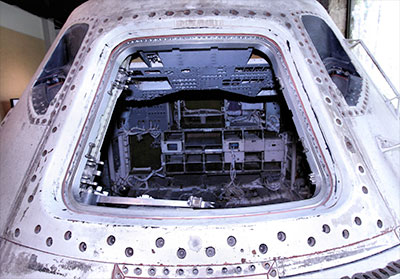 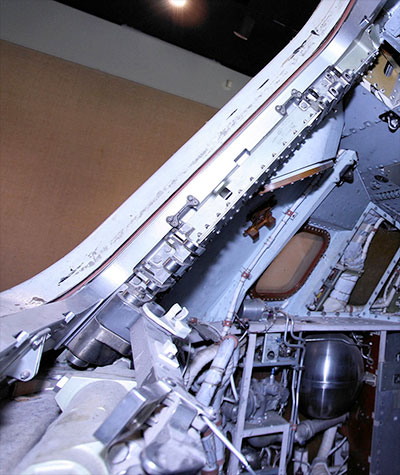
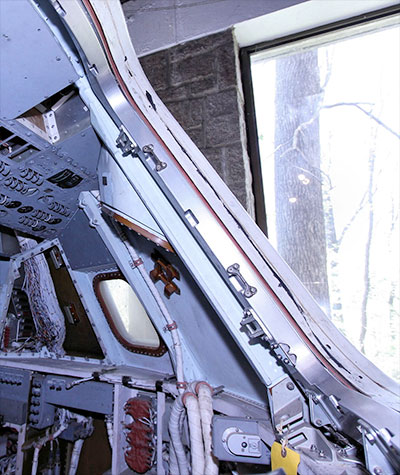
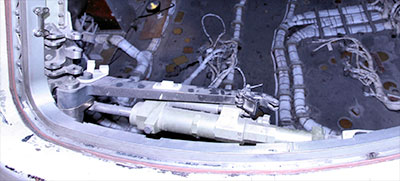
|
PeterMart
Member Posts: 16
From: Texas
Registered: Aug 2007
|
 posted 09-13-2020 12:47 PM
posted 09-13-2020 12:47 PM
   
My takeaway from viewing the Apollo 4 hatch: the business end of the locking mechanism was the hatch with its six bolts. The CM itself basically had a groove and the six locking fairings for the bolts.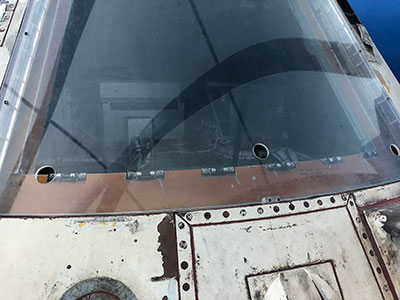 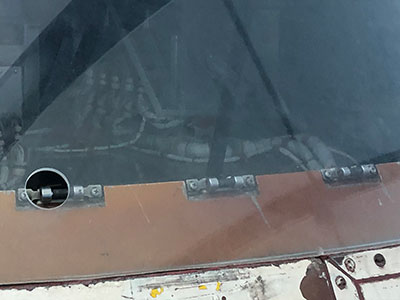
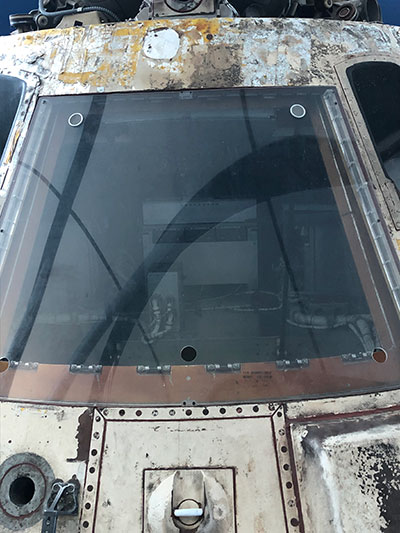
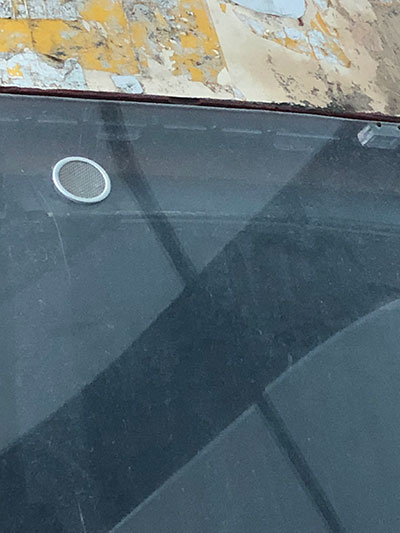
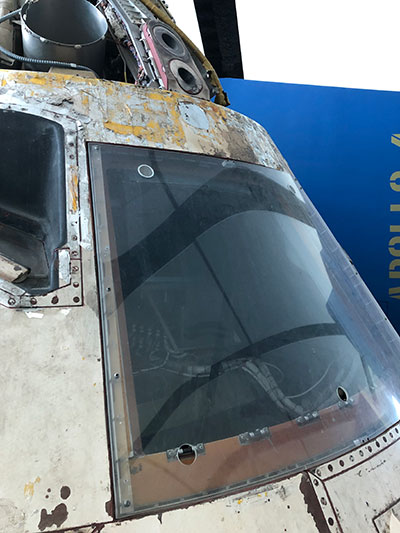
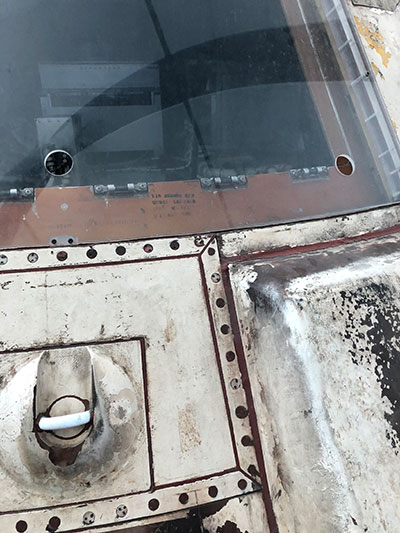
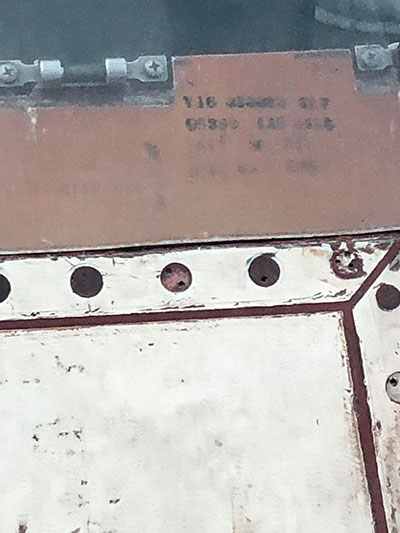
|
Fra Mauro
Member Posts: 1678
From: Bethpage, N.Y.
Registered: Jul 2002
|
 posted 09-13-2020 04:20 PM
posted 09-13-2020 04:20 PM
   
Great photos. It's interesting to see inside Apollo 4, no finishes in it. |
PeterMart
Member Posts: 16
From: Texas
Registered: Aug 2007
|
 posted 09-13-2020 08:34 PM
posted 09-13-2020 08:34 PM
   
I really wish the folks at Infinity would put a small light inside of the capsule and a small raised platform on which to stand/look downward. There is some interesting stuff (60's era computers) inside, but it's very dark as not much ambient light makes it through the plexiglass. |
Graves
New Member Posts: 4
From: Pearlington MS
Registered: Jan 2019
|
 posted 09-14-2020 08:01 AM
posted 09-14-2020 08:01 AM
   
We have discussed putting a light to help visibility, and I have used a crappy endoscope I bought myself to try and get a better view inside, but we decided to wait until the planned renovation of Apollo Alley into the Fred Haise Space Gallery, and that keeps getting pushed into the future for funds and other reasons. |
oly
Member Posts: 1093
From: Perth, Western Australia
Registered: Apr 2015
|
 posted 09-15-2020 12:22 AM
posted 09-15-2020 12:22 AM
   
This paper about the Apollo Command Module Side Access Hatch System (pages 157 to 167) delivered at the 4th Aerospace Mechanisms Symposium in 1969 has an excellent description of the Block II Unified Hatch design including the adapter modules used to modify the command module design to incorporate the unified hatch. There are details of the design requirements and also about the change requirements approved after the Apollo 1 fire. |


























